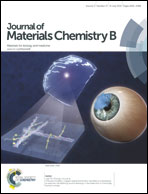Synthesis of amphiphilic reduced graphene oxide with an enhanced charge injection capacity for electrical stimulation of neural cells†
Abstract
Advanced neural research demands new electrode materials with high performance. Herein, we have developed a facile approach to synthesize amphiphilic reduced graphene oxide (rGO) and demonstrated its performance in electrically stimulating neural cells with high charge injection capacity. Synthesis of the amphiphilic rGO features covalent functionalization and simultaneous thermal reduction in a one-step manner. The covalent functionalization of methoxy poly(ethylene glycol) (mPEG) chains on the rGO surface not only provides a high dispersibility in various solvents, enabling convenient post-treatment processes, but also allows for an enhancement in double-layer charging capacitance. Calcium imaging of PC12 neural cells on the amphiphilic mPEG–rGO films has revealed a predominant increase in the percentage of cells with higher action potentials, derived from double-layer capacitance enhancement in charge injection. These results suggest that the new amphiphilic mPEG–rGO material is capable of providing a much safer and efficacious solution for neural prostheses applications.


 Please wait while we load your content...
Please wait while we load your content...